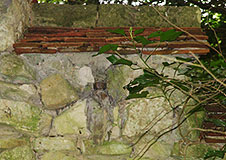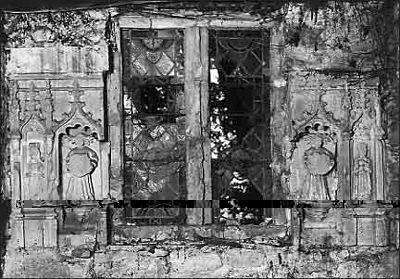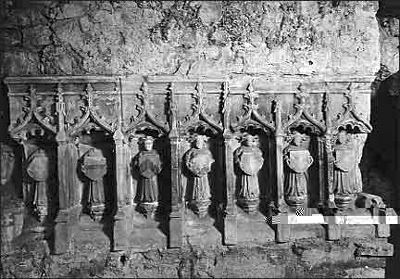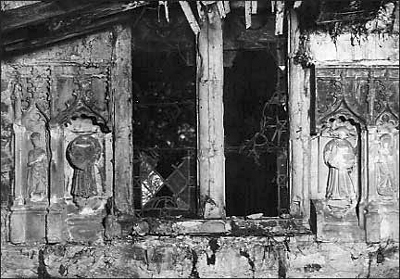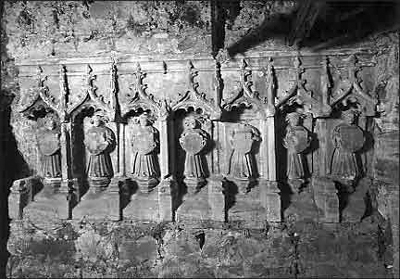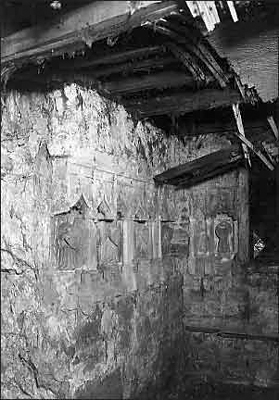 The Grotto can be found in a wood at the west end of the grounds of Hasley Manor. At the time of its construction, the Grotto would have been more visible than it is today and would have had a view of the river. In the spring, there is an area carpeted with snowdrops. (Photo left 1969 of Tanya Egan and Terry Green.)
The Grotto can be found in a wood at the west end of the grounds of Hasley Manor. At the time of its construction, the Grotto would have been more visible than it is today and would have had a view of the river. In the spring, there is an area carpeted with snowdrops. (Photo left 1969 of Tanya Egan and Terry Green.)
In the late 1700s, it was the vogue for the gentry to have a folly or Grotto built on the grounds of their country houses, either on the skyline or in the garden, to enhance the view. The Ruinous Grotto at Thornton was a kind of summer house with seating all around.
It was built in the late 1700s by Dr William Cotton and his son-in-law Thomas Sheppard as part of the building programme that ravaged the church.
However, the Gentleman’s Magazine (December 1801) applauded the alterations, describing the church as a neat and commodious building and a pattern for all churches and chapels for true devotion.
The church’s chancel and chantry chapels were presumed to be pulled down because of structural damage. It was more economical to make the church smaller as the parish had shrunk. The demolished parts were taken to build the Grotto.
The door of the Grotto was gothic—the windows and the glass date from the 14th century.
|
The magnificently carved sides of Robert Ingylton’s tomb chest, mediaeval floor tiles and fragments of stained glass were carted off from the church to embellish the curious Grotto, where they were discovered in 1945. In 1946, after 150 years of relegation in fragments to the garden grotto, Robert Ingylton’s tomb chest was reassembled, returned to the church and placed in the nave, to be joined in 1994 by the effigy of the 14th-century priest discovered beneath the floorboards in the north aisle.
|

2002 |
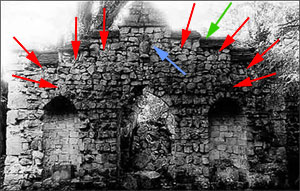
1991
|
The red arrows on the picture (above right) indicate where iron anchors and cement are. It is thought that they held the faces of dragons. In 1945 Major Owen Evans made a note saying he saw a wood dragon face hanging on one of the points. Statues are thought to have been in the arches on either side of the Gothic door. These may have been sold in the 1904 sale of the estate. The blue arrow shows the position of the stone corbel (see pic below)
|

The stone corbel above the door came from the church. Another similar size was found during the 1994 restoration work on the church. (Now mounted inside the church on the west wall of the south aisle.)
Frost has severely damaged it. This picture showed its condition in 1962.
|
All the walls were capped with red handmade tiles, possibly made at the local Hasley brickworks. Note the iron anchors and cement. Pic. July 2002.
The walls of the Grotto are made from local limestone. The central arch shows the collapsed cave (with rubble from the pinnacle above the cave structure).
Initially, there was a sloping Welsh slate roof. Presumably, there was a gutter at the back. The roof began to collapse in the 1940s, and nothing remains.
|
|
|
On the floor were several tiles known to have been made at Penn in Buckinghamshire during the 14th century. The four tiles form a pattern as follows:-
A bird’s head in each corner. Four squiggles in the centre and closed within a circle, out of which grew 12 multi-foils enclosed within a larger circle.
These were surrounded by more prominent, later red and black Victorian tiles.
Another single tile was also found. It is presumed that it might have come from the church.
|
 Tile type 1 Tile type 1 |
 Tile type 2 Tile type 2 |
|
Below are pictures of Robert Ingylton’s tomb inside the Ruinous Grotto, taken in 1946.
The pigments and gold have worn off the carvings, although there are still traces of chevrons and bars on the shields. The window frames survive in the Grotto, but the glass was vandalised many years ago.
|
|
|
End of Tomb Chest and pieces of mediaeval stained glass (now destroyed)
|
|
|
|
|
|
|
The opposite end of the Tomb Chest
|
|
|
The remaining side of the Tomb Chest
|
|
|
Collapsing ceiling with lath and plaster giving way
|
Chapman of Buckingham took pictures in 1945.
|
 The Grotto can be found in a wood at the west end of the grounds of Hasley Manor. At the time of its construction, the Grotto would have been more visible than it is today and would have had a view of the river. In the spring, there is an area carpeted with snowdrops. (Photo left 1969 of Tanya Egan and Terry Green.)
The Grotto can be found in a wood at the west end of the grounds of Hasley Manor. At the time of its construction, the Grotto would have been more visible than it is today and would have had a view of the river. In the spring, there is an area carpeted with snowdrops. (Photo left 1969 of Tanya Egan and Terry Green.)




